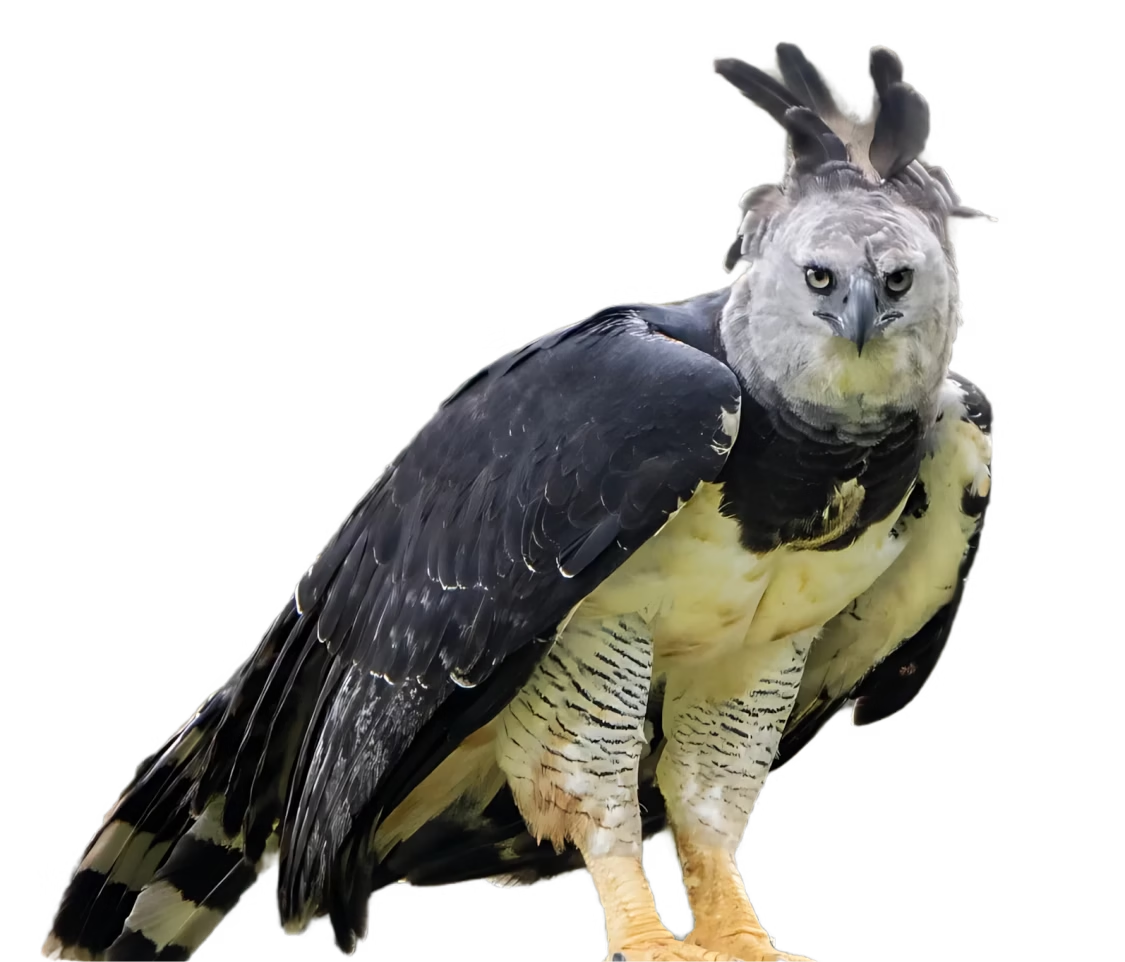Harpy
Eagle
Majestic
Guardian
of a Healthy
Biodiversity
Majestic and endangered, the Harpy Eagle (Harpia harpyja) is one of the largest raptors in the world, but also the inspiration and driving force behind our conservation efforts. Its presence signifies ecological health and serves as a call to protect what remains of Colombia’s tropical rainforests.
Who is
the Harpy Eagle
The Harpy Eagle is one of the largest and most powerful birds of prey in the world. Native to the tropical rainforests of Central and South America, this iconic raptor plays a vital role as an apex predator, helping regulate populations of medium-sized mammals like monkeys and sloths.
With its striking appearance—massive talons, a prominent feathered crest, and piercing eyes—the Harpy Eagle has become a symbol of strength, resilience, and ecological balance. Yet despite its power, it is a threated species of extintion.

Key Characteristics
of the Harpy Eagle
Family
Accipritidae
Scientific name
Harpia harpyja
Habitat
Lowland tropical rainforests with tall, emergent trees
Elevation limit
0- 900 m
Wingspan
Up to 2 meters
(6.5 feet)
Weight
6 to 10 kg
(13–22 lbs)
Diet
Monkeys, sloths, opossums, anteaters, and large birds
Lifespan
Up to 35 years in the wild
Nesting
Builds massive nests high in emergent trees; lays a single or a cuuple eggs every 2–3 years
Conservation
status
Vulnerable (VU-UICN), with severe local declines in Colomb
Why the Harpy Eagle Matters?
An Apex Predator
with a Fragile Future
The Harpy Eagle, a top predator in tropical forests, regulates species like monkeys and sloths, maintaining ecosystem balance. However, habitat loss, hunting, and fragmentation have made it one of the most threatened birds in the Americas.
Largest rainforest
raptor in the Americas
with a wingspan up to 2 meters and powerful talons as large as a grizzly bear’s claws.
Slow reproductive cycle
lays one egg every 2–3 years, making population recovery extremely slow.
Indicator species
its survival reflects the overall health of its forest habitat.
Highly sensitive to disturbance
it requires vast, continuous forest to nest and hunt.
An
extraordinary
Life
cycle
cycle
Harpy Eagle
The Harpy Eagle, with its patience and dedication, lays one or two eggs every two or three years. Parents dedicate more than a year to raising their young, ensuring strong offspring, although this makes the species vulnerable. At the Harpy Eagle Nature Reserve, we protect the nests and the long journey of each eagle, as every successful flight begins with years of care.
Our
conservation
actions
Protecting the Harpy Eagle Means
Protecting the Rainforest
Our 10-year Conservation Action Plan places the Harpy Eagle at the center of our work. Through research, habitat restoration, and environmental education, we ensure that this species—and the forest it depends on—has a future.
Our core
conservation
strategies

This is the heading
We’ve increased the protected area from 0 to 250 hectares and actively restore degraded lands.

Monitoring and Research
We use camera traps, drone mapping, and field observations to monitor eagle behavior and other animals, territory use, and breeding.

Community Engagement
We educate nearby communities about the eagle’s importance and involve them in protection efforts.

Responsible ecotourism
Revenue from tourism activities helps fund conservation efforts, support local jobs, and raise awareness about the Harpy Eagle's ecological importance.
Let Us
Introduce
You to Our
Harpy Eagle Family
Apolo, Chimuela, Isis, La Tía, and Morocho are part of a story that gave life to this reserve.
They are not just majestic birds—they are family. Each one of them represents a chapter in our journey to protect the rainforest and preserve the future of this iconic species. Their presence reminds us why we care, why we study, and why we act.
Here, we invite you to get to know the individuals behind the wings—the Harpy Eagles that turned a forest into a mission.
APOLO
In this species, male harpy eagles are significantly smaller than females; the males hunt while the females incubate the eggs and care for the young. However, they are lethal and incredibly fast within the forest. Males court females by offering them prey.
ISIS
Female harpy eagles are very protective of their chicks, feeding and guarding them until they are able to fly. They remain in the nest for about six months without moving to any other branch of the nesting tree—always staying in the nest from the moment the egg is laid until the chick is around four months old.
MOROCHA
Born at the end of December 2021, she was expelled by her parents at just 14 months of age—a very short stay for her species. She headed toward the Serranía de la Macarena National Natural Park, and we never saw her again after she left the nest.
CHIMUELA
She has been her parents’ spoiled one. After two years in the nest, she still hasn’t been expelled. She is a fierce predator and continues to defend the fork of her nest aggressively—even from her parents. She’s very curious and sometimes comes down to the ground, near the reserve’s hides.
TIA
We affectionately call her “Tía” (Aunt), as this eagle is not a harpy eagle, but a crested eagle (Morphnus guianensis). She visited the nest several times bringing food for the female and for Morocha. This was a very special event, as it’s extremely rare to see these two important eagles together—especially with this kind of behavior.
Meet
the Harpy
family
Discover the incredible story of Isis, Apolo, Morocho, and Chimuela—the Harpy Eagle family that gave birth to our reserve and inspired a dream of nature conservation. Visit their forest. Witness their legacy. Be part of their protection.
-
VISIT THEIR
FOREST HOME. -
WITNESS
THEIR LEGACY. - BE PART OF THEIR PROTECTION.
How you
can help
THE HARPY
EAGLE’S STORY
The survival of the Harpy Eagle depends on long-term, collective action. You can contribute to protecting this iconic species and its habitat by supporting our reserve.
get involved
Make a Donation
Help fund monitoring,
habitat protection,
and education.
Join Our Experiences
Participate in eco-tours,
workshops, and
conservation projects.
Visit the Reserve
Your stay directly
supports
conservation.
Spread the Word
Share the story of the
Harpy Eagle and its
forest home.
Follow us in Instagram: Share withn your friends the Harpy Eagle IG and the content






